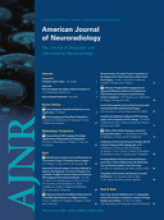Research ArticleBrain
Optimized Preload Leakage-Correction Methods to Improve the Diagnostic Accuracy of Dynamic Susceptibility-Weighted Contrast-Enhanced Perfusion MR Imaging in Posttreatment Gliomas
L.S. Hu, L.C. Baxter, D.S. Pinnaduwage, T.L. Paine, J.P. Karis, B.G. Feuerstein, K.M. Schmainda, A.C. Dueck, J. Debbins, K.A. Smith, P. Nakaji, J.M. Eschbacher, S.W. Coons and J.E. Heiserman
American Journal of Neuroradiology January 2010, 31 (1) 40-48; DOI: https://doi.org/10.3174/ajnr.A1787
L.S. Hu
L.C. Baxter
D.S. Pinnaduwage
T.L. Paine
J.P. Karis
B.G. Feuerstein
K.M. Schmainda
A.C. Dueck
J. Debbins
K.A. Smith
P. Nakaji
J.M. Eschbacher
S.W. Coons

References
- 1.↵
- Sugahara T,
- Korogi Y,
- Tomiguchi S,
- et al
- 2.↵
- Hu LS,
- Baxter LC,
- Smith KA,
- et al
- 3.↵
- Paulson ES,
- Schmainda KM
- 4.↵
- Boxerman JL,
- Schmainda KM,
- Weisskoff RM
- 5.↵
- 6.↵
- Lev MH,
- Ozsunar Y,
- Henson JW,
- et al
- 7.↵
- 8.↵
- Bruening R,
- Kwong KK,
- Vevea MR,
- et al
- 9.↵
- Sugahara T,
- Korogi Y,
- Kochi M,
- et al
- 10.↵
- 11.↵
- Juluru K,
- Vogel-Claussen J,
- Macura KJ,
- et al
- 12.↵
- Hu LS,
- Baxter LC,
- Paine TL
- 13.↵
- Donahue KM,
- Krouwer HG,
- Rand SD,
- et al
- 14.↵
- Rosen BR,
- Belliveau JW,
- Vevea JM,
- et al
- 15.↵
- Boxerman JL,
- Hamberg LM,
- Rosen BR,
- et al
- 16.↵
- Perkiö J,
- Aronen HJ,
- Kangasmäki A,
- et al
- 17.↵
- Sadeghi N,
- Salmon I,
- Decaestecker C,
- et al
- 18.↵
- 19.↵
- Roberts HC,
- Roberts TP,
- Brasch RC,
- et al
- 20.↵
- Manka C,
- Träber F,
- Gieseke J,
- et al
- 21.↵
- Wedeking P,
- Eaton S,
- Covell DG,
- et al
- 22.↵
- 23.↵
- 24.↵
- Brandsma D,
- Stalpers L,
- Taal W,
- et al
- 25.↵
In this issue
Advertisement
L.S. Hu, L.C. Baxter, D.S. Pinnaduwage, T.L. Paine, J.P. Karis, B.G. Feuerstein, K.M. Schmainda, A.C. Dueck, J. Debbins, K.A. Smith, P. Nakaji, J.M. Eschbacher, S.W. Coons, J.E. Heiserman
Optimized Preload Leakage-Correction Methods to Improve the Diagnostic Accuracy of Dynamic Susceptibility-Weighted Contrast-Enhanced Perfusion MR Imaging in Posttreatment Gliomas
American Journal of Neuroradiology Jan 2010, 31 (1) 40-48; DOI: 10.3174/ajnr.A1787
0 Responses
Optimized Preload Leakage-Correction Methods to Improve the Diagnostic Accuracy of Dynamic Susceptibility-Weighted Contrast-Enhanced Perfusion MR Imaging in Posttreatment Gliomas
L.S. Hu, L.C. Baxter, D.S. Pinnaduwage, T.L. Paine, J.P. Karis, B.G. Feuerstein, K.M. Schmainda, A.C. Dueck, J. Debbins, K.A. Smith, P. Nakaji, J.M. Eschbacher, S.W. Coons, J.E. Heiserman
American Journal of Neuroradiology Jan 2010, 31 (1) 40-48; DOI: 10.3174/ajnr.A1787
Jump to section
Related Articles
- No related articles found.
Cited By...
- Identification of a Single-Dose, Low-Flip-Angle-Based CBV Threshold for Fractional Tumor Burden Mapping in Recurrent Glioblastoma
- Arterial Spin-Labeling and DSC Perfusion Metrics Improve Agreement in Neuroradiologists Clinical Interpretations of Posttreatment High-Grade Glioma Surveillance MR Imaging--An Institutional Experience
- Presurgical Identification of Primary Central Nervous System Lymphoma with Normalized Time-Intensity Curve: A Pilot Study of a New Method to Analyze DSC-PWI
- Performance of Standardized Relative CBV for Quantifying Regional Histologic Tumor Burden in Recurrent High-Grade Glioma: Comparison against Normalized Relative CBV Using Image-Localized Stereotactic Biopsies
- Perfusion MRI-Based Fractional Tumor Burden Differentiates between Tumor and Treatment Effect in Recurrent Glioblastomas and Informs Clinical Decision-Making
- Moving Toward a Consensus DSC-MRI Protocol: Validation of a Low-Flip Angle Single-Dose Option as a Reference Standard for Brain Tumors
- Optimization of Acquisition and Analysis Methods for Clinical Dynamic Susceptibility Contrast MRI Using a Population-Based Digital Reference Object
- Effects of MRI Protocol Parameters, Preload Injection Dose, Fractionation Strategies, and Leakage Correction Algorithms on the Fidelity of Dynamic-Susceptibility Contrast MRI Estimates of Relative Cerebral Blood Volume in Gliomas
- MRI Evaluation of Non-Necrotic T2-Hyperintense Foci in Pediatric Diffuse Intrinsic Pontine Glioma
- Contrast Leakage Patterns from Dynamic Susceptibility Contrast Perfusion MRI in the Grading of Primary Pediatric Brain Tumors
- Comparison of the Effect of Vessel Size Imaging and Cerebral Blood Volume Derived from Perfusion MR Imaging on Glioma Grading
- The Added Prognostic Value of Preoperative Dynamic Contrast-Enhanced MRI Histogram Analysis in Patients with Glioblastoma: Analysis of Overall and Progression-Free Survival
- Impact of Software Modeling on the Accuracy of Perfusion MRI in Glioma
- Repeatability of Standardized and Normalized Relative CBV in Patients with Newly Diagnosed Glioblastoma
- ASFNR Recommendations for Clinical Performance of MR Dynamic Susceptibility Contrast Perfusion Imaging of the Brain
- Bayesian Estimation of Cerebral Perfusion Using Reduced-Contrast-Dose Dynamic Susceptibility Contrast Perfusion at 3T
- Comparison of 18F-FET PET and Perfusion-Weighted MR Imaging: A PET/MR Imaging Hybrid Study in Patients with Brain Tumors
- Arterial Spin-Labeling Assessment of Normalized Vascular Intratumoral Signal Intensity as a Predictor of Histologic Grade of Astrocytic Neoplasms
- Diagnostic Accuracy of Dynamic Contrast-Enhanced MR Imaging Using a Phase-Derived Vascular Input Function in the Preoperative Grading of Gliomas
- The Role of Preload and Leakage Correction in Gadolinium-Based Cerebral Blood Volume Estimation Determined by Comparison with MION as a Criterion Standard
- Correlations between Perfusion MR Imaging Cerebral Blood Volume, Microvessel Quantification, and Clinical Outcome Using Stereotactic Analysis in Recurrent High-Grade Glioma
- Multimodality Assessment of Brain Tumors and Tumor Recurrence
This article has not yet been cited by articles in journals that are participating in Crossref Cited-by Linking.
More in this TOC Section
Similar Articles
Advertisement











